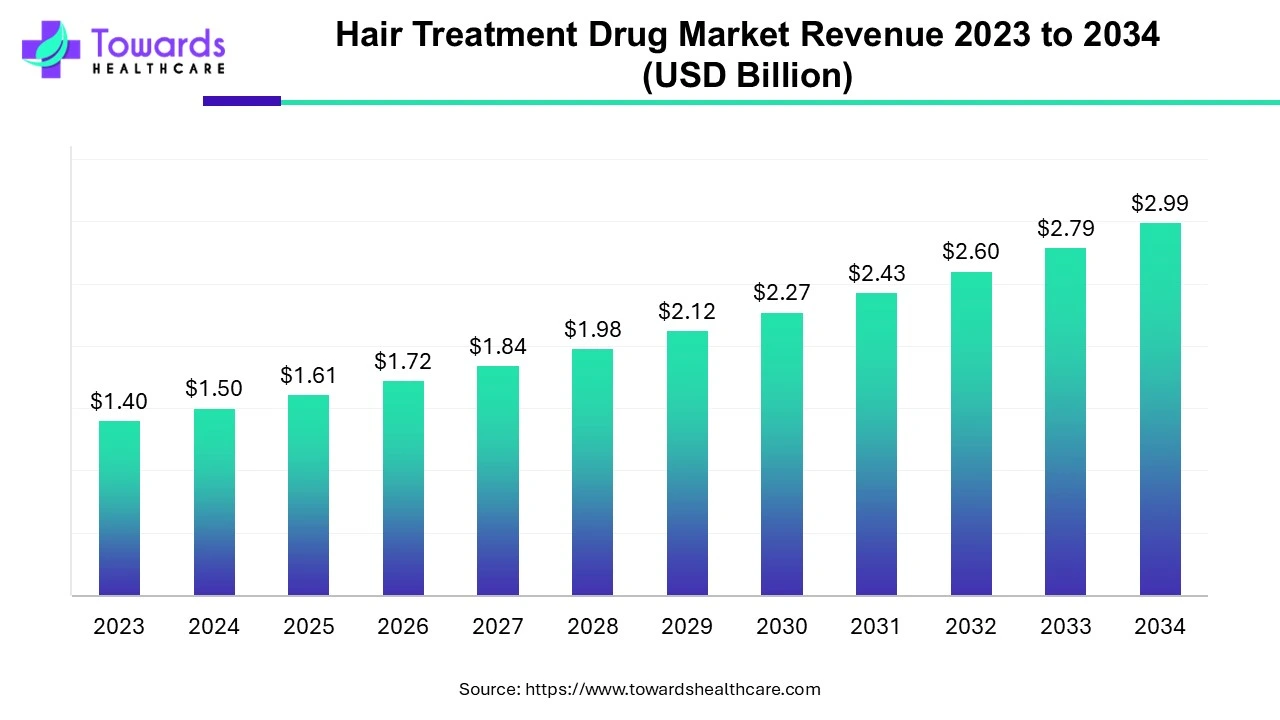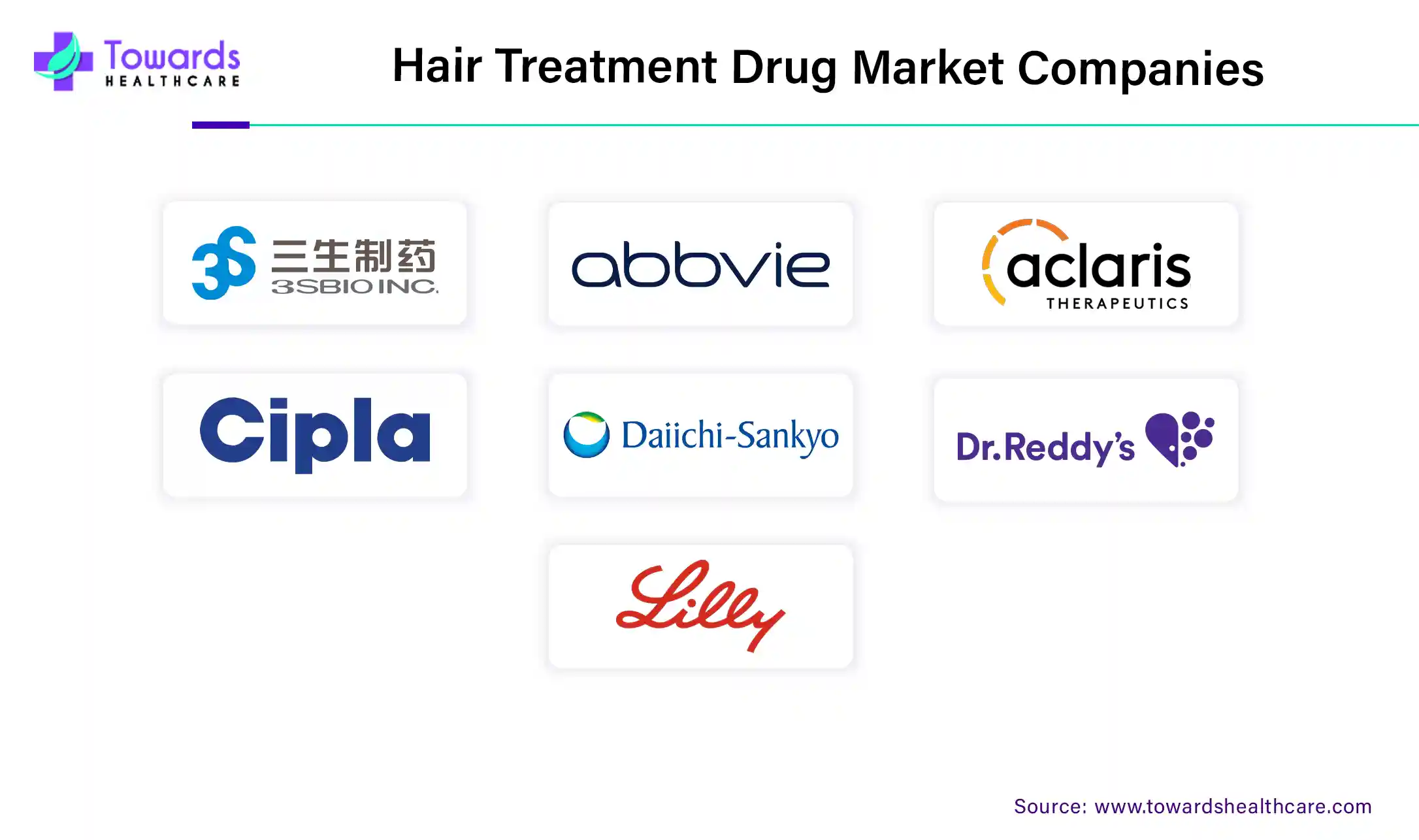April 2025

The hair treatment drug market was estimated at US$ 1.4 billion in 2023 and is projected to grow to US$ 2.99 billion by 2034, rising at a compound annual growth rate (CAGR) of 7.14% from 2024 to 2034. The increasing incidences of hair loss, growing research and development, increasing investments drive the market.

Hair loss is a common condition in which a human loses more than 100 strands a day. Effective treatments are available for some types of hair loss. The different types of hair loss include androgenetic alopecia; alopecia areata; telogen effluvium; anagen effluvium; hypotrichosis; lichen planopilaris; discoid lupus erythematosus, etc. Such hair loss disorders can be treated using various medications. The OTC medications include some natural compounds like biotin, zinc, collagen, azelaic acid, and oils like tea tree oil.
However, if these OTC drugs are ineffective, healthcare professionals prescribe medications such as minoxidil, finasteride, antiandrogens like spironolactone and oral contraceptives, corticosteroids, antifungal drugs, etc. depending on the type and severity of the hair loss.
The increasing incidence and prevalence of hair loss cases potentiate the demand for hair treatment drugs. The rising prevalence of hair loss affects both males and females of all ages due to hormonal imbalances, immune disorders, pollution, and drug-induced hair loss. Additionally, the growing research & development for new drug discovery and development boosts the market.
The rising prevalence of hair loss disorders has increased the demand for novel drug discovery to treat these disorders. Hair treatment drug research is a rapidly evolving field. The R&D activities are encouraged by the recent three US FDA drug approvals within two years. Apart from discovering novel drugs, researchers are developing novel drug delivery systems, both oral and topical, for targeted drug delivery and reduced side effects. Additionally, many researchers consider repurposing existing drugs to eliminate the complex and lengthy drug discovery process.
For instance, Dutasteride, a prescription medication for treating enlarged prostate glands, is studied for treating genetic pattern hair loss in men. Furthermore, a deeper understanding of the normal hair growth cycle, disease conditions affecting hair growth, and drug targets involved in hair loss is necessary to develop novel drugs with better efficacy and lesser side effects.
Hair treatment drugs have numerous side effects such as excessive hair growth, changes in hair color or texture, or hair loss, thereby restricting the use of hair treatment drugs. Moreover, there is a major stigma around the globe associated with hair treatments. This limits the consumer adoption for such treatments and drugs by creating a major restraint for the industry.
North America held a dominant presence in the hair treatment drug market in 2023. The state-of-the-art research & development facilities, the presence of key players, and the rising prevalence of hair loss drive the market. Hair loss characterized by autoimmune disorders affects around 700,000 individuals in the US, out of which 300,000 people suffer from severe hair loss.
It is reported that around 20% of white males have androgenetic alopecia or male pattern baldness accounting for around 3 million men in Canada and 35 million men in the US. Major US pharma giants are working on novel drugs for treating hair loss. Recently, two novel hair treatment drugs, one developed by Eli Lilly & Incyte Corporation and the other developed by Pfizer, were approved by the US FDA from 2022 to 2024. This promotes more advanced drug discovery for better outcomes. Additionally, increasing investments & collaborations boost market growth.
Asia-Pacific is expected to grow fastest in the hair treatment drug market during the forecast period. The rising incidences of hair loss, sedentary lifestyles, and expanding research and development drive the market. Hair loss is a major concern in Asia-Pacific countries. It has been reported that more than 200 million Chinese suffer from hair loss.
According to a survey conducted on more than 500,000 individuals in India, around 60% of young men under 25 have hair loss due to increased stress levels, and 37% of people have hair loss due to poor gut health. The increasing number of clinical trials in the region potentiate novel drug discovery and development. Additionally, an improved healthcare regulatory environment for the use and approval of hair treatment drugs boosts the market.
By type, the topical medication segment held the largest share of the hair treatment drug market in 2023. Topical medications are most widely used for treating hair loss to enhance targeted drug delivery and reduce systemic side effects. Minoxidil is one such example of topical medication available in liquid or foam to stop hair from thinning and promote new hair growth. Other examples of topical medications include corticosteroids, anthralin, or topical immunotherapy.
The oral medication segment held a notable share of the hair treatment drug market in 2023. Oral medications are the treatment of choice in cases where the cause of hair loss is hormone imbalance or immune disorder. The rising prevalence of hair loss caused by hormonal imbalance or autoimmune disorders augments the segment’s growth.
By application, the hair clinics segment accounted for a considerable share of the market in 2023. The segment growth is attributed to the increasing number of patients in hair clinics due to skilled professionals. Healthcare professionals prescribe drugs based on the patient’s condition.
The pharmacy segment is anticipated to grow with the highest CAGR in the market during the studied years. OTC medications for hair treatment are the first preference of patients and are easily available in local pharmacy retail stores. The availability of generic medications, special discounts, and same-day home delivery services potentiate the segment growth.

By Type
By Application
By Region
April 2025
April 2025
April 2025
April 2025